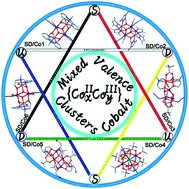Self-assembly, structures, magnetic properties and solution behaviors of six mixed-valence cobalt clusters†
Abstract
The introduction of multidentate chelating ligands and secondary small inorganic anions into a variable-valence cobalt synthesis system led to the formation of six novel mixed-valence cobalt clusters, namely, [CoII2CoIII2(mdea)2(OH)2(2,2′-bipy)2(CH3CN)4]·4ClO4·2H2O (SD/Co1), [CoII2CoIII2(dmhmp)6(CH3CN)4]·4ClO4·4CH3CN (SD/Co2), [CoIICoIII4(mdea)4(N3)4(piv)2] (SD/Co3), [CoII2CoIII2Na(mdea)2(N3)(piv)8] (SD/Co4), [CoII4CoIII2(dea)2(Hdea)4(piv)4]·2piv (SD/Co5), and [CoII2CoIII2(mdea)2(dmpea)2(OH)2(CH3CN)2(H2O)2]·4ClO4·2H2O (SD/Co6) (H2dea = diethanolamine, H2mdea = N-methyldiethanolamine, 2,2′-bipy = 2,2′-bipyridine, Hdmhmp = 3,5-dimethyl-1-(hydroxymethyl)-pyrazole, Hpiv = pivalic acid and dmpea = 1-(3,5-dimethyl-1H-pyrazol-1-yl)-ethanimine). Among them, compounds SD/Co1, SD/Co2 and SD/Co6 have a similar cationic tetranuclear core motif {Co4O6} consisting of two CoIII and two CoII mixed-valence ions. Compound SD/Co3 has two similar neutral pentanuclear {Co5O8} clusters co-crystallized in one asymmetric unit that each contains four CoIII ions and one CoII ion. Compound SD/Co4 consists of a bimetallic pentanuclear calyx-like {Co4Na} skeleton including two CoIII and two CoII ions, while compound SD/Co5 has a cationic hexanuclear rod-like cluster {Co6O8} consisting of two CoIII and four CoII ions. In addition, the high-resolution electrospray ionization mass spectrometry (HRESI-MS) technique was introduced to detect their solution behaviors and reveal their evolutional processes. Magnetic measurements indicated that these cobalt clusters show distinct magnetic behaviors at low temperature.



 Please wait while we load your content...
Please wait while we load your content...